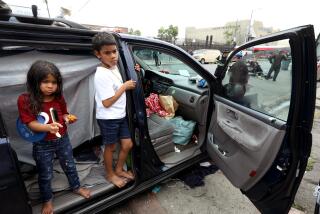In Beijing, shipping containers double as community center
Reporting from Beijing — Inside the shipping containers stacked like Lego blocks and painted bright, pastel colors, groups of middle-school students sat in newly renovated classrooms scribbling in notebooks and joking distractedly with their friends.
Their classrooms at a 19-container community center in Heiqiao Village, a dusty sprawl in suburban Beijing, had survived a summer run of local government closures and demolitions of more than 30 schools for migrant children in the Beijing area. Almost 15,000 youths lost their gathering places for studying and socializing.
Officially, local authorities considered the schools that closed “unsafe” and “unhygienic.” But some migrant education experts believe the closings were more likely a heavy-handed effort by district officials to get migrant families to move away.
“The government has a bad name for these migrant workers — they call them the ‘low-end population,’ ” said Song Yingquan, an expert on migrant education at Peking University. “They’re trying to stop children from going to school in order to send parents back to their hometowns.”
During the last decade, an estimated 116 million people from China’s hinterlands have struck out for its booming coastal cities in the hope of finding better lives, bringing the country’s total migrant population to about 260 million. Government officials expect that number to increase by at least 300 million during the next few decades.
But under China’s hukou, or residence registration system, migrant workers are not entitled to the same social benefits as city dwellers, including the right to enroll their children in free public schools. In Beijing, many migrant children attend unregulated “migrant schools,” where tuition is high despite often underqualified teachers and overcrowded classrooms.
Song said many families would rather brave the uncertainties and the difficulties of life in the cities than return to their rural hometowns, where opportunities are in short supply.
“They’re just moving from one place to another,” he said. “Very, very few of them go home.”
According to recent census data, about 7 million migrants live in Beijing, making up roughly a third of the city’s population. Many are poorly paid construction workers, cooks and security guards who have little choice but to settle in low-rent “migrant villages” such as Heiqiao.
Such villages are often built on cheap land that the government has designated for construction projects, making whole communities vulnerable to demolition on short notice.
“As soon as they want to expand the road, this place is gone,” said Zhou Jun, a mechanic working just outside the gates of the community center in Heiqiao, pointing to a two-lane road a quarter of a mile from his shop.
Compassion for Migrant Children, the nonprofit organization responsible for building the center in Heiqiao at a cost of about $150,000, is well acquainted with the sting of demolition. After more than two years in operation, one of the organization’s centers was razed in 2009 to make way for an office complex, leaving families in the lurch.
Now the organization believes the shipping container setup in Heiqiao, which provides after-school programs for about 70 youths and has room to grow, can survive even if the surrounding village is marked for demolition, said Yin Chia, communications manager. The group plans to build dozens of additional centers.
“We can just put the center on a truck and move with the community,” she said, adding, “Donors are … very concerned about the sustainability of their donations. We can’t be sustainable if we keep getting demolished.”
Many migrants have come to accept the constant threat of demolition as an unavoidable part of life in the capital and other cities.
Xia Ling, 32, said her family moved to Heiqiao two years ago after their last home in Beigao, another migrant village in suburban Beijing, was condemned to make way for a government project no one seems willing or able to describe.
“The whole village was knocked down, including the school,” she said, watching her 3-year-old daughter play by the center’s basketball courts. “About 1,000 students had to just move on.”
Although her daughter is too young to attend the after-school program, Xia hopes to enroll her eventually.
“We’ll take her wherever she can get a basic education,” she said. “I don’t want my daughter to work in a kitchen her whole life.”
Kaiman is an intern in The Times’ Beijing bureau.
More to Read
Sign up for Essential California
The most important California stories and recommendations in your inbox every morning.
You may occasionally receive promotional content from the Los Angeles Times.










